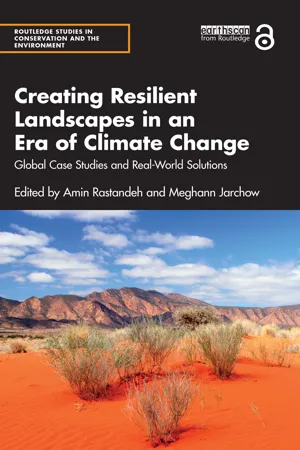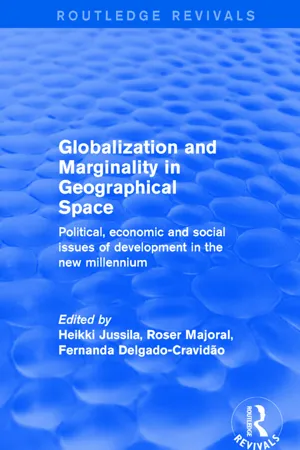History
Farming on the Great Plains
Farming on the Great Plains refers to the agricultural practices and challenges faced by settlers in the central United States during the late 19th and early 20th centuries. The region's arid climate, lack of trees for building, and the need for irrigation systems presented significant obstacles to successful farming. Despite these challenges, settlers adapted by using new technologies and farming methods to cultivate the land and establish thriving agricultural communities.
Written by Perlego with AI-assistance
Related key terms
3 Key excerpts on "Farming on the Great Plains"
- eBook - ePub
Creating Resilient Landscapes in an Era of Climate Change
Global Case Studies and Real-World Solutions
- Amin Rastandeh, Meghann Jarchow, Amin Rastandeh, Meghann Jarchow(Authors)
- 2022(Publication Date)
- Routledge(Publisher)
Figure 5.1 ). The Great Plains tends not to be mapped primarily as an economic or political region. It is instead delineated in terms of a semi-arid climate and flat, sloping, rolling topography, physio-geographic factors shaped by the geologic forces of marine sedimentation, mountain uplift, and erosion, which manifest in ecoregional plant communities and which, in tandem with human sociocultural and economic activities, help determine the region’s agricultural vegetation. At the risk of oversimplifying: the “plains” shape and support the “grassland” of tallgrass, mixed-grass, and shortgrass “prairies.”In the late 1800s, US federal government incentives to encourage settlement westward, such as the Homestead Act, brought many settlers into the Great Plains. With this migration, settlers began converting prairie landscapes into agricultural production through farming and ranching to produce annual grains and livestock (Cunfer & Krausmann, 2015 ). According to the 2011 Atlas of the Great Plains,Throughout the region, more than 80% of the land is used for agricultural activities, including ranching. Only on the margins of the Plains is less than half of the land devoted to agriculture. This pattern emerged in the early 20th century and has continued ever since.(Lavin et al., 2011 , p. 131)The reality of the agricultural landscape that has been built and maintained through settler colonial systems in Indigenous homelands is not the totality of the Great Plains, but given its current dominance, we take it as one important starting point for grappling with questions of resilience. The farming part of this agricultural reality has led to the region being both recognized and mythologized as the “breadbasket,” ecologically vulnerable to drought as during the Dust Bowl1 but nevertheless stocking the world’s granaries with staple grains, with wheat in particular continuing to reign “both on the ground and in the region’s psyche” (Morris, 2011 - eBook - ePub
- Dennis Ojima, Jean Steiner, Shannon McNeeley, Karen Cozzetto, Amber Childress(Authors)
- 2015(Publication Date)
- NCA Regional Input Reports(Publisher)
Table 2.1 ). Changes in land use management, climate, and hydrological extremes will impact how natural resources will be utilized and sustained over time in the Great Plains, affecting the region’s social wellbeing and ecosystem integrity.In the nine Great Plains states (Colorado, Kansas, Montana, Nebraska, North Dakota, Oklahoma, South Dakota, Texas, and Wyoming) there are approximately 510,405 farms and 340,653,196 total acres (1,378,575 km2 ) in farms (USDA National Agricultural Statistics Service 2009). Approximately 42% or 143 million acres (578,700 km2 ) is in cropland and approximately 52% or 178 million acres (720,300 km2 ) is in permanent / native pastures. Of the 143 million acres (578,700 km2 ) of cropland, in 2007 over 22 million acres (89,000 km2 ) were planted to corn, over 4.8 million acres (19,400 km2 ) were planted to cotton, over 5.6 million acres (22,700 km2 ) were planted to sorghum, over 14.2 million acres (57,500 km2 ) were planted to soybeans, and over 29.5 million acres (119,400 km2 ) were planted to wheat (USDA National Agricultural Statistics Service 2009). An additional 14.8 million acres (59,900 km2 ) of cropland were in improved pastures and 15 million acres (60,700 km2 ) of Great Plains farmland were in the CRP program.BEEF CATTLE PRODUCTIONBecause of the vast quantities of native rangelands, livestock production (mostly beef cattle) is one of the most important sectors in US Great Plains agriculture, both economically and socially. On average, 30% (North Plains) to 68% (South Plains) of total farm production value in the Great Plains comes from beef cattle (McBride and Matthews 2011). - eBook - ePub
Globalization and Marginality in Geographical Space
Political, Economic and Social Issues of Development at the Dawn of New Millennium
- Heikki Jussila, Roser Majoral, Fernanda Delgado-Cravidao(Authors)
- 2017(Publication Date)
- Routledge(Publisher)
Globalization is not something new to the mid latitude grasslands, as pointed out earlier in this paper. Since their 19th century colonization, these lands have had to deal with large trading firms, ever-larger food processors, a more diverse group of commodity markets, and shifting governmental regulations and tariffs (domestic and foreign). Restructuring has been an ongoing process for agriculture throughout this period. Still, this ‘new’ globalization is immensely broader in scope and presents the grasslands with another, altered set of challenges.The significance of globalization for the Great Plains can be ascertained by considering wheat production and export volumes for the U.S. in recent decades (Figures 4.2 , 4.4 ). Although export volumes specifically attributable to the ten Great Plains states are not available, these states have accounted for between half and two-thirds of total U.S. wheat production at every Census since 1930 (Figure 4.3 , Table 4.1 ). Annual figures averaged by decade show a substantial increase in total U.S. wheat production from just under 30 million metric tons in the 1950s to 62 million per year during the 1980s. For the period since 1960 an average of 56% of each year’s crop was exported. However, this average disguises enormous variation involving a range as high as over 70% in 1963, 1972, 1988 and 1989, and as low as below 40% in 1960, 1968, 1971, 1985 and 1990 (Figure 4.4 ).Using the proportions of total U.S. wheat output in the ten Great Plains states for Census years since 1960 as a guide (Table 4.1 ), about 55% to 65% of the wheat raised in these states in recent decades has been intended for the export rather than domestic market. The enormous fluctuation in foreign demand for U.S. wheat thus has tended to have a deleterious effect. Demand instability has been one of the factors prompting substantial farm consolidation within the region. While the total area in farms in the Great Plains changed little over the last half century, average farm size increased from 229 hectares in 1950 to 399 in 1990 (Table 4.1
Index pages curate the most relevant extracts from our library of academic textbooks. They’ve been created using an in-house natural language model (NLM), each adding context and meaning to key research topics.


